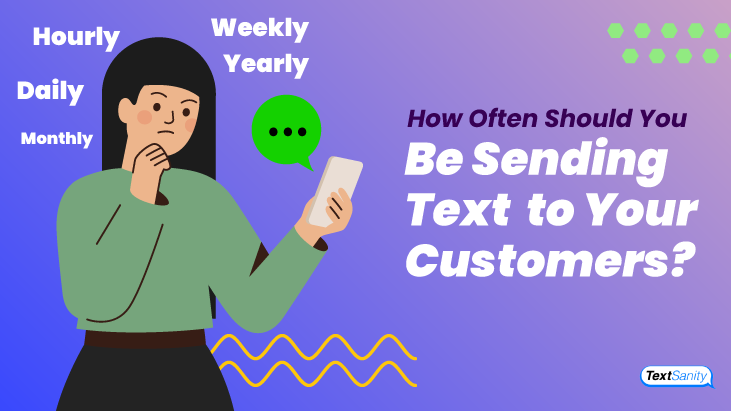How Often Should You Be Sending Texts to Your Customers?
If there’s one thing to know in communication, it’s when enough is enough.
The cadence and rhythm of sending SMS messages to your customers should be well-thought-out and intentional, not random. Failing to do so will lead to annoyed customers who take their numbers off your text marketing contact list.
We don’t want this to happen to your company. You work too hard to keep your company’s growth sustainable. We want to help make your SMS marketing strategy efficient and productive through well-timed texting.
 What is text marketing?
What is text marketing?
Text marketing simply refers to using Short Messaging Service (SMS) text messages to deliver promotional and transactional information to customers and prospects.
Instead of sending the marketing material through email or the postal service, you send it directly to the customer’s messaging app.
The beauty of SMS is that it’s universally accepted across all devices and software platforms. Therefore, whether your customer uses an iPhone, Android device, or “dumb-phone,” they’ll receive your marketing messages.

You can send any marketing message you could send through the mail, in a newspaper ad, or even on the radio through a text message. The only thing that changes is the medium in which the message is delivered, not the message itself.
 Why use text marketing?
Why use text marketing?
There are two important reasons why you should use text marketing in your marketing strategy. The first, and most significant, is text marketing gets results unmatched by other methods. It’s not even close.
The open rates for text messaging marketing services are well ahead of other communication channels, and SMS campaigns also carry better response rates and customer satisfaction.
For instance, if you send a marketing message via text message and email, consumers are 134% more likely to respond to the text, and 86% of businesses have seen higher engagement on their texts over email as well. The fact is that texting dramatically outperforms email marketing and therefore features a much higher Return on Investment (ROI).
The second big reason you should be using SMS marketing fuels the first reason. After all, 97% of people own a cell phone. Many people report becoming anxious when they leave their phones behind.
These metrics paint a very bright and obvious picture — customers won’t be without their phones for long, which means your marketing message has a greater chance of being delivered. Moreover, customers will open the message and engage with it nearly 100 times more than with email.
Additionally, text message marketing opens up a vast treasure trove of customer data collection. This data can later be used to tailor marketing messages to distinct customer groups or audiences to increase the likelihood of engagement and conversion.

Easy opt-in
It’s easy to get customers to opt-in to text messaging from your business, especially when you utilize a text marketing webform on your ecommerce site. Simply create and customize a text marketing webform on your TextSanity account and then put the link on your site. It’s that simple.
When a customer inputs their mobile phone number into the webform on your website, the information is immediately sent to your TextSanity account, where an automated message is sent to the customer requesting opt-in.
Customers can also opt-in for appointment reminders, follow-ups, and real-time product updates by texting your TextSanity number, chosen when you sign up for a TextSanity account, with a text message keyword campaign.
Opt-ins are a critical element of SMS marketing and regulated by the FCC. Before you can send a text message to a customer, they must first opt-in and agree to receive future notifications.
This is designed to protect the privacy of customers. Additionally, customers must have an easy way to opt-out and unsubscribe.
Less intrusive
SMS marketing and business text messaging are far less intrusive than other marketing mediums. Text messages are quickly received and categorized on the customer’s mobile device and can be easily deleted or interacted with.

Unlike email, customers frequently text on their phones, far more often than sending emails. They will appreciate receiving a text versus an email because of its convenience. For this reason, mobile marketing can be a smoother messaging platform for customer support, new product information, and other bulk messages than other forms of communication, such as email or snail mail.
Offers integrations
The TextSanity WordPress plugin integration and text marketing developer API are great ways to use TextSanity’s platform. All are excellent examples of focusing on an overall marketing strategy interconnected across all your touch points.
Each integration helps opt-in customers and categorize your customer information into defined audiences for future SMS text marketing campaigns.
Increases engagement
We will say this until we’re blue in the face because we want to drive it home. Text message marketing can yield high rates of engagement. Engagement rates are an important metric because companies with higher engagement will likely see more sales.
It’s not enough to simply send a marketing message. If there’s no engagement, then there’s no sale.
 How often should you send text messages to customers?
How often should you send text messages to customers?
How often you should send text messages to customers depends on the message type, the intended results, and the customer type. There’s no right or wrong answer when it comes to customer communication.
However, a text marketing strategy that doesn’t make intentional efforts to create a cadence and rhythm often result in a loss of subscribers. Therefore, it is essential to find what works for your text messaging services while keeping it simple.

Find the sweet spot
Start by finding out what resonates with your audience. Take an honest look at your marketing campaign and consider the target audience. What are your target audience’s age and gender demographics? Why are these customers tagged together? Are they current customers? Did they just purchase a product? Has it been a while since they bought your product?
These are all questions you need to ask because they influence what kind of cadence and rhythm your marketing campaign should have. For instance, you wouldn’t want to send a customer who just purchased a product a text two days later telling them you miss them.
If you plan to send daily mass texts, it’s probably not a good idea to send frequent ads driving customers to make a purchase. Daily texts are better suited for general information messages.
Find your sweet spot for the specific campaign, and don’t overdo it. Sometimes less truly is more.
Keep it simple
Keep it simple. We’ve designed our entire platform around that wisdom. Sending marketing text messages should be easy and efficient, as should the messages. Don’t overthink it. Put yourself in the customer’s shoes.
Think about a company that has gotten on your nerves with marketing messages, and then think of one that didn’t. What was the difference between the two?
Mix it up
It’s a great idea to mix up your marketing messages. Throw in some fun between the business messages. For instance, having contests or sweepstakes is a great way to engage with customers, get them engaged with your company, and make it fun.
Another option would be to send a grilling tip or a fun fact once a week. The possibilities are practically limitless.
You don’t want your customers to become irritated whenever they get a notification that you’ve sent them a text message. You want them to be excited to see what you have up your sleeve today and wonder what you will think up next.
The overall effect of mixing it up means your customers will indeed have a pleasant customer experience with your SMS marketing campaigns. Not only will they likely continue to remain opted into receiving text messages, but they may also stay loyal to your brand.
 When is it too much texting?
When is it too much texting?
While no defined metric indicates a line in the sand for too much texting, you should monitor your opt-in and opt-out rates to see if you are on the right track.
If you’re noticing a sharp decline in your customer database despite sustained or increased sign-ups, you are most likely texting too much or at least need to change your cadence and rhythm.

The bottom line
The bottom line is there’s no set-in-stone rule for how often you should text your customers. Your company’s cadence and rhythm will be unique to your company culture, mission, products delivered, and services.
Your customers may be unique from other companies, so figuring out your cadence and rhythm will require taking an honest and intentional strategic approach.
You know your customers, and you know what drives them. One common rule to follow is what we started with — know when enough is enough. You should be able to take an objective look at your marketing strategy to determine if you’re approaching the “too much” realm.
Your text marketing should be fun for both you and the customer. If they’re having fun and finding value in the service, your cadence and rhythm are on point.
Give us a call today, or connect with us on our website and discover how TextSanity can amplify your SMS marketing.


